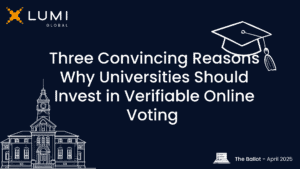End-to-end verifiability: such a crucial component of secure online voting systems, yet one whose importance is often understated. In this edition of The Ballot, we break down end-to-end verifiability and how it lays the groundwork for secure digital elections.
You Can’t Have a Secure Online Election without E2E-V
You might have known this already if you read our blog post or a previous edition of The Ballot, but we can’t help ourselves in stating it again: there’s no such thing as 100% safe online voting without E2E-V.
Why is that? Well, the biggest clue is in the name: “end-to-end” verifiability. In the simplest of terms, this means that the system can be fully “verified” (or checked for accuracy) from one “end” (casting ballots) to the other (tallying and releasing results.) This means that you – as an administrator, observer, or voter – can take a peek in the system and check for yourself that no funny business is happening while an election is ongoing.
A useful way to summarize this characteristic is “universal verifiability.” Via a public bulletin board in the system, anyone involved in a voting event can see for themselves that all is working according to plan. To go back to our original point, if a system can’tbe verified “universally,” how can you possibly trust that the results are correct?
E2E-V Voting Systems Ensure Three Critical Things
E2E-V systems are characterized by being transparent, secure, and trustworthy by design. But, when it comes to ballots, what specific things do these systems actually ensure? We’ve broken it down into three simple points:
- Votes are cast how voters marked them
If you select option 1, your cast ballot will have option 1 selected.
- Votes enter the system the same way voters marked them
Your ballot marked with option 1 enters the digital ballot box unaltered.
- Votes are counted the same way they entered the system
Your “option 1” ballot in the system is counted as a vote for option 1.
Most importantly, if a voting system is lacking any one of these assurances, it is not E2E-V!
E2E-V Systems Reach Their Full Potential with Voters’ Help
Even the most sophisticated pieces of technology still need a human touch. In order to guarantee “individual verifiability,” meaning that voters can verify the accuracy of their cast ballots, voters also have an important role to play in E2E-V voting solutions.
First, voters must be able to confirm that their ballots are marked correctly. They may do this via a “Benaloh challenge,” whereby a voter decrypts their encrypted ballot just before casting it. A voter can then see their choices, confirm that their ballot is marked correctly, and then go back to cast their ballot.
Second, voters must be able to confirm that their unaltered vote made it into the ballot box. Using a code they received after casting their ballot, voters can confirm that their ballot made it into the digital ballot box. If the system cannot find the voter’s ballot, a voter can then contact an administrator who can then check the system for signs of tampering.
Intrigued by what E2E-V online voting systems have to offer? Read more about E2E-V in more detail here, along with how our solution Electa raises the bar for E2E-V online voting.
This article was originally posted as the March edition of Assembly Voting’s monthly LinkedIn newsletter, The Ballot. To see older editions, subscribe, and stay up to date with what we’re up to, head to the homepage of The Ballot on LinkedIn here.


